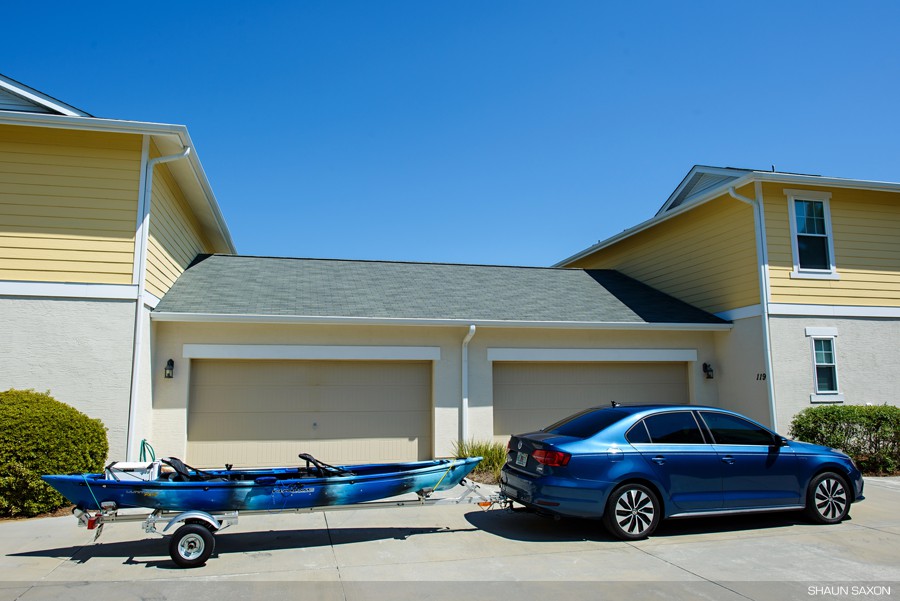@ecarfan (the OP) and I have traded some PMs yesterday and we agreed that the discussion was better suited for this thread. Paraphrasing his question, he wanted to know my speculation about whether a Model X or a Model 3 would have more range towing a Safari Condo Alto trailer, assuming both cars have the same battery capacity. This was an interesting question and I didn't know how it would play out exactly.
Let's set the stage with some assumptions. First, I'll assume the highway speed is 65 mph for the calculations. This allows us to use the EPA range data as a direct reference. (These cars get about their EPA range when traveling at 65mph.)
Here're some other specs I'll use:
Safai Condo Alto trailer
Model R-1723
Weight: 2000 lbs (loaded)
Width: 83"
Height: 83"
Approx Frontal Area: 6,889 sq in [83x83]
Model 3 75D (mythical)
Width: 74.2"
Height: 56.5"
Approx Wake Area: 4,192 sq in [74.2x56.5]
Model X 75D
Width: 81.5"
Height: 66.3"
Approx Wake Area: 5,403 sq in [81.5x66.3]
Instead of focusing on the range, which is dependent on the actual battery capacity, I'll concentrate on the energy used to go a given distance and can be expressed as Wh/mi. We need to determine the "clean" efficiency of each car, then add the trailer to each and finally compare the results.
Let's assume a Model 3 60 goes 225 mi, a 60D goes 5% more or 236 mi. A 75D, with a heavier battery taking off 33% of the gain, goes 17% further [(75/60-1)*0.67] or 276 mi. That's 75kW for 276 mi or
272 Wh/mi for a clean Model 3 75D.
The Model X 75D EPA range is 238 mi. That's 75kW for 238 mi or
315 Wh/mi for a clean Model X 75D.
Now the real fun begins, the fine folks at
TeslaXCanada have provided some nice empirical data for us to use. Their 257 mi (EPA) X 90D gets knocked down to 110 mi range at 55 mph when pulling the Alto. In fact, they give 3 data points at 45, 50 and 55 mph. With that data, I plotted, curve fitted, and extrapolated the range to 65 mph. A reasonable polynomial fit puts the range at 85 mi with a 90D. That's a 67% reduction [1-85/257] by pulling the trailer. A similar reduction for the X 75D would be to 78.7 mi [238*0.3307] and 75kW for 78.7 mi is 953 Wh/mi. So
953 Wh/mi for a Model X 75D with Alto at 65 mph.
And now it gets complicated, since we need to translate the energy the Model X uses to tow to what the Model 3 might use. We could just subtract 315 from 953 to get 638 Wh/mi of additional energy needed to tow the trailer. Adding that to the clean Model 3 272 Wh/mi would yield 910 Wh/mi. However, that doesn't account for the smaller Model 3 providing a smaller wake for the trailer. In effect, the trailer behind the Model 3 experiences more wind and therefore has a higher drag force than behind the Model X. The Model 3 would therefore need to provide more than 638 Wh/mi to tow the trailer. How much more is very hard to answer because it depends on complicated aerodynamics that are hard to simplify.
Let's attempt to do this by first breaking apart the 638 Wh/mi into two components: tire rolling friction and aerodynamic drag. The trailer is light, especially compared to it's size, so I'll assume the tire friction is 25% of the 638 so 160 Wh/mi [638*0.25] is used to roll the vehicle. That leaves 478 Wh/mi [638*0.75] to overcome aero drag. The Model X wake (very roughly) shadows 78% [5403/6889] of the trailer leaving 22% of it exposed. A Model 3 wake only shadows 61% [4192/6889] of the trailer and leaves 39% exposed. The trailer's wind exposure goes from 22% to 39%, increasing by 1.77x. So the aero drag might increase from 478 to 846 Wh/mi behind the Model 3 [478*1.77]. This is a
very hand-wavy approximation!
Adding it all back up, the Model 3 towing efficiency is the sum of 272 (clean Model 3) plus 160 (trailer rolling friction) plus 846 (trailer aero drag). That's
1,278 Wh/mi for a Model 3 75D with Alto at 65 mph. If you're familiar with these numbers, that should give you serious pause right there!
Comparing these numbers says that the Model 3 is 34% [1-1278/953] less efficient than the Model X when towing this trailer. I'm not sure I believe this number.
I don't want to believe this number! But I don't have a better way to approximate the aero effects of the smaller Model 3. Will the Model 3 only go
51.9 mi [78.7 * (1-0.34)] pulling this trailer at 65mph? I hope not. That's a 81% (!) range loss [1-51.9/272]. However, I firmly believe that the 43 Wh/mi [315-272] advantage the Model 3 has when clean will definitely be exceeded by the additional drag of the Model 3 pulling this trailer instead of the Model X. That difference was 368 Wh/mi [846-478] using my rough approximation for the drag. Even if my drag calculation is 5 times too high, the additional drag will still exceed the Model 3's 43 Wh/mi advantage. [368/5 = 73.6 > 43]
To summarize:
--The Model X 75D with Alto loses 67% range and can go 78.7 mi range at 65 mph.
--A mythical Model 3 75D with Alto loses 81% range and can go 51.9 mi range at 65 mph. (Hopefully more, but likely not near 78.7 mi.)
Two final points:
1) The Model 3 motors or battery might not be able to handle the thermal load associated with producing 1.3kWh/mi continuously. In fact, I'd be very impressed if it did. That's discharging 83 kW [1.278*65] in 48 minutes [51.9/65*60] or only a little less than Supercharger charging power.
2) Traveling at 65 mph is not necessary. Slowing to 55 mph, increases the efficiency and range by about 29% [1-110/85]. The Model X/Alto would use 739 Wh/mi [953/1.29] and go 102 mi [78.7*1.29]. The Model 3/Alto would use 991 Wh/mi [1278/1.29] and go 67 mi [51.9*1.29].
This took a longer than I expected but was insightful for me. I really hope I'm overestimating the drag increase of the Model 3 pulling this relatively efficient trailer. I welcome anyone to suggest a better method to estimate the drag.
Bottomline, I don't see the Model 3 being a practical travel trailer tow vehicle.





